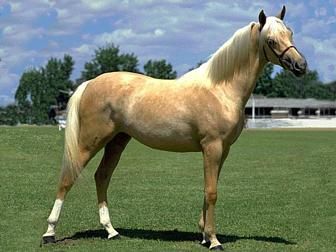
OVERVIEW
Most breeds are classified according to lineage, but the Palomino is determined by color. Various breeds of horses can be Palominos. Quarter Horses make up about fifty percent of registered Palominos, while the remainder are Thoroughbreds, Standardbreds, American Saddle Horses, Arabians, Morgans and Tennessee Walking Horses. It is difficult to breed Palominos, as they do not regularly perpetuate their coloring genetically. Bred to one another, Palominos produce chestnuts or cremellos (a horse with 2 cream genes) as often as they produce a horse of their own color type. For more on cremellos and perlinos visit the Cremello & Perlino Educational Association web site http://www.doubledilute.com/
PHYSICAL DESCRIPTION
The Palomino is frequently a subject of attention since its bright coloring distinguishes it from other horses. The skin of the Palomino may be dark or light, although the coat must be gold in color. The coats of dark-skinned Palominos often turn white in winter, while light-skinned maintain the gold coloring year round. The Palomino stands between 14 and 17 hands. The mane and tail are white, and the eyes must be brown, black or hazel.
ORIGIN
The origin of the Palomino is determined, in terms of conformation, by considering the origin of the breed of which it is a member.
INTERESTING FACTS
The Palomino gains its name from the Royal family in Spain, Palomina. Horses with Palomino coloring have been very popular throughout history. Cortes brought a number of Queen Isabella'a Palominos with him to America in 1519. Some of these, or their offspring, eventually escaped and contributed to the Palomino coloring once common in Mustangs. Although Palominos are found in many different breeds, about 50 percent are registered Quarter horses.
INFLUENCES
1. Spanish
For more information:
Palomino Horse Association